 Proteomics researchers may be missing complete proteome coverage if they use only trypsin as the protease of choice for shotgun analysis. Giansanti et al. (2016) published a practical reference paper that details optimized protocols for using alternative proteases, with additional notes on best practices for each.1
Proteomics researchers may be missing complete proteome coverage if they use only trypsin as the protease of choice for shotgun analysis. Giansanti et al. (2016) published a practical reference paper that details optimized protocols for using alternative proteases, with additional notes on best practices for each.1
Shotgun proteomics, also known as bottom-up proteomics analysis, relies on mass spectrometric characterization of the peptide soup generated from proteolytic digestion of biological samples. Researchers take advantage of the well-characterized proteolytic activity of trypsin to identify peptide fragments from spectral data, which in turn enables coverage of the whole proteome. However, by relying on only the most common protease enzyme, Giansanti et al. suggest that researchers may miss important cleavage sites and post-translational modifications that trypsin either avoids or disrupts.
As a solution, and to enhance shotgun proteomics experiments, the coauthors present a convenient protocol optimized for six alternative protease enzymes. Each of these substitute enzymes is active on alternative cleavage sites within proteins to generate a different set of peptide fragments. Proteome coverage is thus more complete with running parallel digestions using multiple proteases, since researchers have more than one range of peptide fragments to explore.
The enzymes explored in the optimized protocol are chymotrypsin, LysC, LysN, AspN, GluC and ArgC. The protocol replicates the standard traditional trypsin digestion methodology as far as possible, and can be completed within two days. Giansanti et al. used a simple protein source (bovine serum albumin, BSA) in addition to a complex sample (Escherichia coli cell lysate) to evaluate each protease enzyme. They completed the proteomic analysis by liquid chromatography–tandem mass spectrometry (LC-MS/MS) on Q Exactive Plus and Orbitrap Fusion tribrid mass spectrometers (both Thermo Scientific) in combination with an ultra-high-performance liquid chromatography system (UHPLC).
In addition to highlighting critical steps for each protease, the authors make the following general points for each protocol:
- Prepare cell lysates, ensuring removal of all insolubles.
- Be aware of reagent compatibility with each protease enzymes.
- Carefully estimate protein concentration before digestion.
- De-salt and clean up the samples prior to LC-MS/MS.
- Include quality control steps for both protein digestion and LC-MS/MS instrument functioning.
In addition to the general protocol, the paper also describes the instrument conditions and programming required to achieve optimal results. The authors also alert researchers with notes of critical steps in the process. As another useful inclusion, they also give an indication of results anticipated with each protease digestion, showing spectral coverage for the BSA and E. coli lysates used for validation.
The paper also discusses limitations and advantages inherent with each protease. Giansanti et al. suggest that researchers be aware of compatibility issues between proteases and the LC-MS/MS process. They also note that researchers should ensure that post-processing algorithms used to identify peptides and proteins work with the enzyme chosen. They also note that using multiplexing isotopic labels can also affect performance, suggesting that for confidence researchers stick to using label-free methods of quantitation, as these are not affected by the nature of the peptide fragments generated by each protease.
Reference
1. Giansanti, P., et al. (2016) “Six alternative proteases for mass spectrometry–based proteomics beyond trypsin,” Nature Protocols, 11 (pp. 993–1,006). doi:10.1038/nprot.2016.057.
Post Author: Amanda Maxwell. Mixed media artist; blogger and social media communicator; clinical scientist and writer. A digital space explorer, engaging readers by translating complex theories and subjects creatively into everyday language.
Leave a Reply